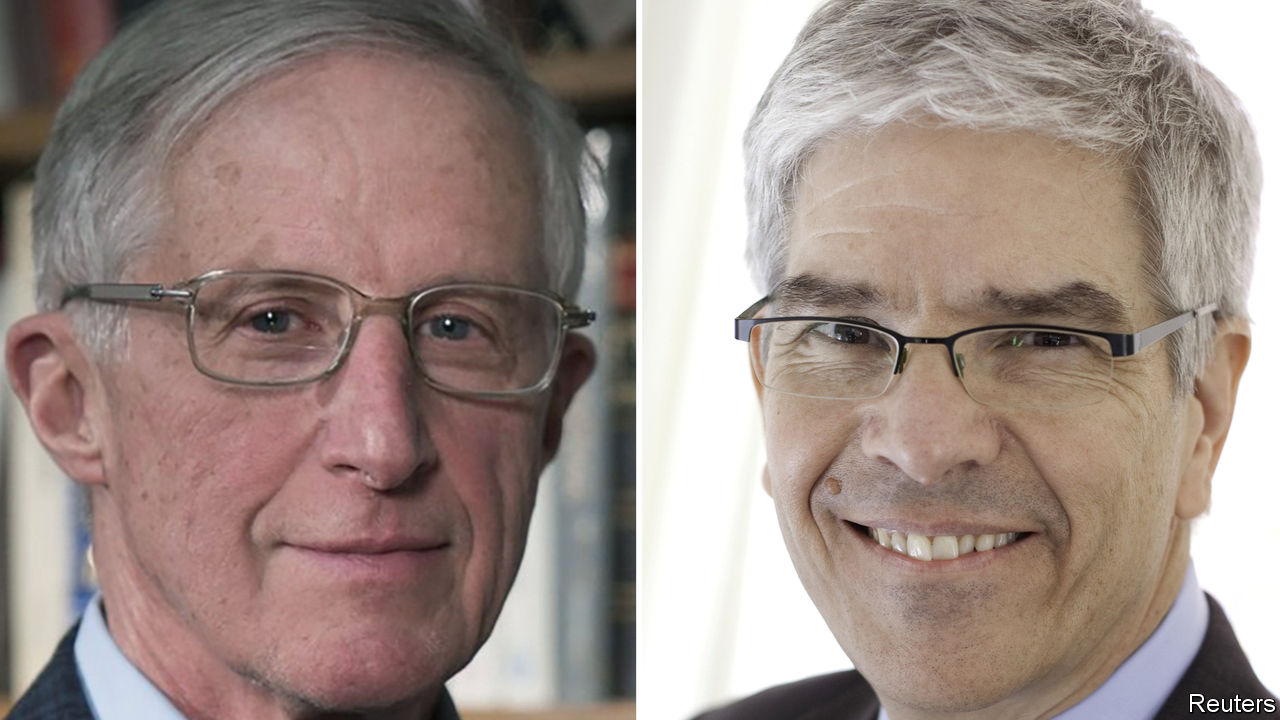The 2018 Nobel prizesThe Nobel prize for economics is awarded for work on the climate and economic g
Posted wanghui626
tags:
篇首语:本文由小常识网(cha138.com)小编为大家整理,主要介绍了The 2018 Nobel prizesThe Nobel prize for economics is awarded for work on the climate and economic g相关的知识,希望对你有一定的参考价值。
The 2018 Nobel prizesThe Nobel prize for economics is awarded for work on the climate and economic growth
Paul Romer and William Nordhaus share the glory

WHY do economies grow, and why might growth outstrip the natural world’s capacity to sustain it? The answers to such questions have long eluded economists. But the profession’s progress towards cracking them is in large part because of this year’s recipients of the Nobel prize for economic sciences, Paul Romer (pictured, right) and William Nordhaus (pictured, left).
At first glance, the two scholars might not seem a natural pairing. But the Sveriges Riksbank, which awards the economics prize, hailed them for “integrating innovation and climate with economic growth”. Both men, in other words, have improved the way their profession thinks about the operation of impossibly complex, crucially important systems.
Latest stories
-
Mieko Kawakami is Japan’s brightest new literary star
-
How NFL contracts give players so little power
-
The website of British Airways needs to become clearer
-
The Nobel prize for economics is awarded for work on the climate and economic growth
-
A right-wing populist is poised to become Brazil’s next president
-
Suicides among British pensioners are falling
Mr Romer’s attention has ranged widely over the course of his career, but his focus has never strayed far from the nature of economic growth. Dismal scientists used to think that sustained growth over the long run depended on technological progress, which was in turn related to the creation of new ideas. But they struggled to pin down how new ideas emerged, and how innovation interacted with other market activity.
Mr Romer searched for answers by probing the “non-rivalrous” nature of new knowledge: the fact that ideas can be exploited endlessly. The firms or people who come up with new ideas can only capture a small share of the benefits arising from them; before long, competitors copy their brainwave and whittle away the innovators’ profits. In Mr Romer’s models of growth, the market generates new ideas. But the pace at which they are generated, and the way in which they are translated into growth, depend on other factors—such as state support for research and development or intellectual-property protections.
The “endogenous growth models” produced by Mr Romer and those influenced by him were once hailed as a critical step towards understanding patterns of economic growth across the globe. They have not quite fulfilled that promise. But their shortcomings have themselves been useful because of what they say about complex systems. What stops, for example, useful and widely available knowledge from translating into broad prosperity? What prevents the diffusion of knowledge, or its translation into growth, in some contexts but not others? By highlighting that the creation and spread of ideas is necessary for growth, but not sufficient for it, Mr Romer identified a rich vein for other researchers to mine.
Mr Nordhaus’s work tackles the interplay of several different complex systems. Awareness of the dangers of environmental damage, and of the threat from climate change, has grown over the past half-century. Understanding the economic costs such damage imposes is essential to answering the question of how much society should be willing to pay to avert environmental destruction. Mr Nordhaus has applied himself to this daunting problem. His most significant work models the economic harms from carbon emissions. To do so, he combined mathematical descriptions of how emissions affect atmospheric carbon concentrations with those of how atmospheric carbon affects global temperature, and how changes in temperature interact with economic activity.
Having constructed such “integrated assessment models”, Mr Nordhaus could project how different trajectories for global carbon emissions would produce different global temperatures. That, in turn, allowed him to estimate the likely economic costs of these different scenarios—and thence what level of reduction in emissions would be economically optimal. His results set the basic framework for climate-policy discussions. He was the first to suggest that warming should be limited to no more than 2°C higher than the world’s pre-industrial temperatures.
As with Mr Romer’s work, Mr Nordhaus’s contributions are also notable for what their shortcomings reveal. His work has prompted vigorous debate about how best to think through the huge uncertainties associated with global warming, from how emissions translate into higher temperatures to how well society can adapt to rapid changes in climate. Both prize-winners made their names grappling with problems that the field both could not understand and could not afford not to understand. They blazed trails that scholars continue to follow—to the benefit of both economics and humanity.
以上是关于The 2018 Nobel prizesThe Nobel prize for economics is awarded for work on the climate and economic g的主要内容,如果未能解决你的问题,请参考以下文章